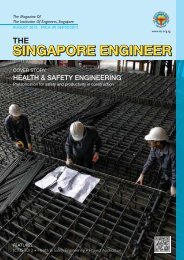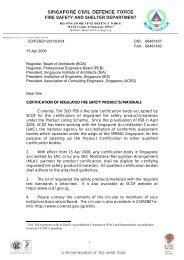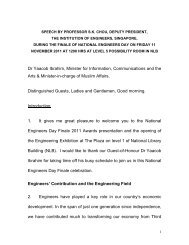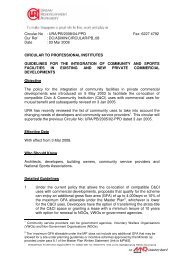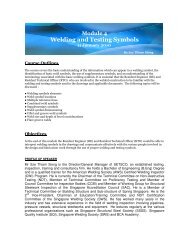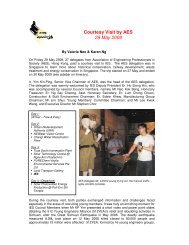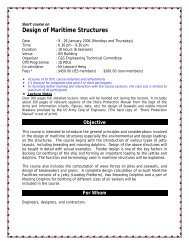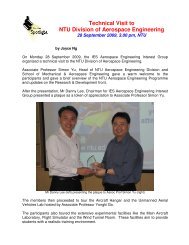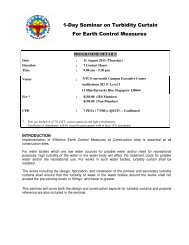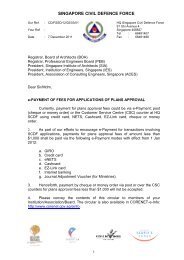THE SINGAPORE ENGINEER - Institution of Engineers Singapore
THE SINGAPORE ENGINEER - Institution of Engineers Singapore
THE SINGAPORE ENGINEER - Institution of Engineers Singapore
Create successful ePaper yourself
Turn your PDF publications into a flip-book with our unique Google optimized e-Paper software.
AEROSPACE <strong>ENGINEER</strong>ING<br />
COVER STORY<br />
and usually exhibit erosion damage in the form <strong>of</strong> deep pits,<br />
cracks and holes. The introduction <strong>of</strong> coatings built primarily<br />
from composite components demands that its protective layers<br />
act as a robust barrier against such impacts, thereby minimising<br />
damage and onset <strong>of</strong> corrosion.<br />
ASTAR’s Institute <strong>of</strong> Chemical and Engineering Sciences has<br />
developed a novel technology for making erosion resistant coatings.<br />
The coatings will combine functional nanoparticles with functional<br />
polymers or commercial paints to form a multi-phased network<br />
with homogeneously distributed discrete elastic phases in a<br />
coating layer matrix. The high erosion resistance stems from the<br />
ability <strong>of</strong> the novel composite network to efficiently absorb the<br />
impact energy from particles in flight conditions and thus reduce<br />
the probability <strong>of</strong> chain scission and cracking <strong>of</strong> the coating layer.<br />
In addition, the nanoparticles also enable the relaxation <strong>of</strong> internal<br />
stress generated from temperature fluctuations under rapidly<br />
changing environmental and weather conditions.<br />
Modelling <strong>of</strong> electromagnetic interactions in an aircraft<br />
The ever-increasing demand for communication, navigation,<br />
and entertainment leads to a heavy adoption <strong>of</strong> high-speed<br />
electronic devices and wireless networks inside the airplane.<br />
Wireless communication inside commercial aircraft has a great<br />
advantage over the available wired communication. It removes<br />
the weight <strong>of</strong> the connecting cables from the aircraft and reduces<br />
the corresponding maintenance fees, leading to cost savings<br />
for companies. This, however, also makes the electromagnetic<br />
environment inside the aircraft inevitably worse. It has become<br />
increasingly important to simulate and analyse electromagnetic<br />
interactions inside the airplane‘s closed environment for reliable<br />
aircraft operational functions.<br />
A*STAR‘s Institute <strong>of</strong> High Performance Computing (IHPC)<br />
has developed an advanced simulation technology to accurately<br />
model the electromagnetic interactions in a closed environment.<br />
The simulation technology makes full use <strong>of</strong> the structural<br />
features <strong>of</strong> the closed environment. It decomposes the original<br />
complex and large problem into several kinds <strong>of</strong> simple subproblems.<br />
These sub-problems are solved by using different<br />
optimised approaches respectively, and then recombined by<br />
the equivalent sources defined on their interfaces. Therefore,<br />
it benefits in terms <strong>of</strong> accuracy and efficiency. Hence, the<br />
developed simulation technology can help engineers design and<br />
efficiently analyse the channel performance and quality. It also<br />
allows engineers to provide suggestions for future selections<br />
<strong>of</strong> wireless technologies (in terms <strong>of</strong> frequency band, output<br />
power, receiving sensitivity etc).<br />
MAINTENANCE, REPAIR, OVERHAUL (MRO)<br />
Cost-effective method to repair damaged aero engines<br />
In today‘s competitive airline market, maintenance <strong>of</strong> aero<br />
engines is an important economic consideration for operators.<br />
Extensive efforts have been directed to the development <strong>of</strong><br />
innovative repair techniques, processes, and use <strong>of</strong> materials to<br />
increase the fraction <strong>of</strong> aero engine components that can be<br />
repaired. Nowadays, laser-assisted processes, such as laser melting<br />
deposition (LMD), laser surface alloying (LSA), and laser-assisted<br />
mechanical micromachining (LAMM), are widely used in aero<br />
engine repairs. The common feature <strong>of</strong> these laser processes<br />
is the employment <strong>of</strong> highly localised thermal s<strong>of</strong>tening <strong>of</strong> the<br />
material by continuous wave laser irradiation focused in front <strong>of</strong> a<br />
miniature cutting tool. However, since it is a heat-assisted process,<br />
it can induce a detrimental heat-affected zone (HAZ) in the part.<br />
Metallurgical changes such as micro-segregation, precipitation <strong>of</strong><br />
secondary phases, presence <strong>of</strong> porosities, solidification cracking,<br />
and grain growth, are frequently observed in the HAZ, which in<br />
turn lead to non-uniformity <strong>of</strong> microstructure and mechanical<br />
properties, and in some worst case scenarios, to the failure <strong>of</strong><br />
aero engine components. Obviously, for the same material used,<br />
the magnitude <strong>of</strong> the HAZ would be directly determined by<br />
the heat input during the laser processes. In this context, it is<br />
desirable to lower the processing temperature to reduce heat<br />
input and hence minimise the HAZ. In response to this need,<br />
A*STAR‘s Institute <strong>of</strong> Materials Research and Engineering is<br />
focusing on nano-structured materials and their application in<br />
aero engine laser repair.<br />
Advanced metal forming technology for<br />
component fabrication<br />
Some types <strong>of</strong> high performance materials such as chromoly<br />
steel, nickel-base alloy and titanium alloy are used for aerospace<br />
engine components. The fabrication cost <strong>of</strong> these materials is<br />
high because these are difficult-to-form materials. Therefore,<br />
the improvement in the near-net-shape forming process for<br />
these materials is necessary to reduce the fabrication cost <strong>of</strong><br />
aerospace components.<br />
A*STAR‘s <strong>Singapore</strong> Institute <strong>of</strong> Manufacturing<br />
Technology(SIMTech) has developed near-net-shape forming<br />
technology for thin walled components <strong>of</strong> light weight materials<br />
and high performance materials by using advanced combined<br />
sheet and bulk forming processes, and optimising forming<br />
process design and die design rules.<br />
Advanced metal forming technology for component repair<br />
Nickel-base and titanium-base superalloys are widely used for<br />
aero-engine components. The damaged parts need periodic<br />
repair or replacement, to avoid loss <strong>of</strong> engine power, efficiency<br />
and breakdown. In most cases, repair is a more feasible solution<br />
than replacement. However, these kinds <strong>of</strong> materials are difficult<br />
to repair due to the issues <strong>of</strong> cracking, oxidation, and maintenance<br />
<strong>of</strong> the grain size and micro-structure in the repaired region.<br />
A*STAR’s SIMTech has developed Laser Aided Additive<br />
Manufacturing (LAAM), a novel technology that can be used to<br />
accurately repair damaged parts and directly manufacture 3D<br />
components. Using low heat input and a high automation level,<br />
this technology has shown significant advantages over traditional<br />
repair processes.<br />
Health monitoring and diagnosis<br />
A*STAR’s Institute for Infocomm Research (I 2 R) has developed<br />
a monitoring and diagnostics system that provides contactless<br />
April 2012 <strong>THE</strong> <strong>SINGAPORE</strong> <strong>ENGINEER</strong><br />
19



